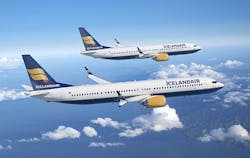Icelandair orders 12 Boeing 737 MAX narrow-body jetliners to expand service in Europe and North America
REYKJAVIK, Iceland, 9 Dec 2012. Commercial air carrier Icelandair based in Reykjavik, Iceland, is buying 12 737 MAX fuel-efficient narrow-body commercial jetliners from the Boeing Co. Commercial Airplanes segment in Seattle, Boeing announced late last week. The deal is worth more than $1.2 billion.
The commitment includes 737 MAX 8s and 9s. "This commitment is the result of our research into what aircraft manufacturers have on offer to help us strengthen and grow our fleet and our network towards the future," says Bjorgolfur Johannsson, Icelandair Group president and CEO.
The 737 MAX, which will enter service in 2017, is a new-engine variant of the venerable Boeing 737. It uses the CFM International LEAP-1B engines to deliver efficiency and reliability. Airlines operating the 737 MAX will see a 13 percent fuel-use improvement over today's most fuel-efficient single-aisle airplanes, Boeing officials say.
The 737 MAX will complement Icelandair's existing 757 fleet to help the carrier expand in North America and Europe. The Icelandair Group currently operates a fleet of 23 Boeing 757 airplanes for passenger and cargo operations.
Boeing officials claim that when compared to a fleet of 100 of today's most fuel-efficient airplanes, the 737 MAX will emit 277,000 fewer tons of carbon dioxide and save nearly 175 million pounds of fuel per year. Worldwide demand for single-aisle passenger jets over the next two decades will be 23,000 aircraft, worth about $2 trillion, Boeing officials predict.
Like its widebody big brother, the Boeing 787 Dreamliner, the Boeing 737 Max has serrated edges called chevrons for the back of the engine nacelle and the engine exhaust nozzle to reduce jet blast noise by controlling the way the air mixes after passing through and around the engine.
The Boeing 737 MAX family will consist of three models -- the MAX 7, MAX 8, and MAX 9 -- that will have different lengths and different seating configurations. The new jets will feature the 737 Boeing Sky Interior with spacious cabin headroom, overhead bins that disappear into the ceiling yet carry more bags that previous interior configurations, and light-emitting diode (LED) lighting.
For more information contact Boeing Commercial Airplanes online at www.boeing.com/commercial.
Follow Avionics Intelligence news updates on Twitter, and join the revamped Avionics Intelligence group on Linkedin at www.linkedin.com/groups/Avionics-Intelligence.
About the Author
John Keller
Editor-in-Chief
John Keller is the Editor-in-Chief, Military & Aerospace Electronics Magazine--provides extensive coverage and analysis of enabling electronics and optoelectronic technologies in military, space and commercial aviation applications. John has been a member of the Military & Aerospace Electronics staff since 1989 and chief editor since 1995.
